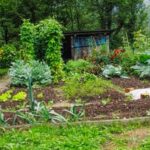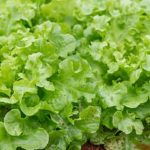Vegetable gardens are not only functional spaces to grow fresh produce but can also be creatively designed to add beauty and aesthetic value to any outdoor area. In this article, we will delve into the world of vegetable garden designs, exploring different layout options, incorporating personal style and themes, and enhancing visual appeal through pathways and water features.
We will also discuss maintenance tips to keep your design fresh and vibrant throughout the seasons. So whether you have a small balcony or a spacious backyard, get ready to explore the artistry of vegetable garden designs.
Having a well-designed vegetable garden goes beyond just creating a space for growing vegetables; it is about maximizing functionality while adding an element of beauty. This unique combination not only enhances the visual appeal of your outdoor area but also brings joy and satisfaction from cultivating your own organic produce.
From layout choices like raised beds, in-ground gardens, or container gardening to choosing themes like rustic, modern, or cottage-style that reflect your personality and taste, there are countless possibilities for infusing creativity into your vegetable garden.
Creativity knows no bounds when it comes to designing vegetable gardens. Even if you have limited space, there are creative ideas such as vertical gardening or window boxes that allow you to cultivate vegetables in small areas.
Additionally, companion planting techniques and ornamental vegetables can add visual interest by combining edible plants with beautiful flowers or herbs. To further enhance the overall design, pathways and edging can be incorporated using various materials like gravel or timber boards to create structure and organization within the garden.
In the following sections of this article, we will dive deeper into different aspects of designing a vegetable garden that encompasses both functionality and aesthetics. We will discuss choosing the right layout for maximizing space and productivity, infusing personal style through themes, incorporating water features for relaxation, and how maintenance practices can keep your design fresh year-round.
So whether you are an experienced gardener or just starting out, get ready to explore the beauty and artistic potential of vegetable garden designs.
Choosing the Right Layout
When it comes to designing a vegetable garden, choosing the right layout is crucial in maximizing space and ensuring optimal productivity. A well-planned layout not only makes efficient use of available space but also takes into consideration factors such as sunlight exposure, soil quality, and ease of maintenance. In this section, we will explore different layout options and provide insights on how to select the most suitable one for your vegetable garden.
Types of Layout Options
One popular layout option is raised beds, which are elevated planting areas filled with soil. Raised beds offer several advantages such as improved drainage, better control over soil quality, and reduced weed growth. They also make it easier for gardeners to reach plants without stepping on the soil, leading to less compaction.
In-ground gardens, on the other hand, involve cultivating vegetables directly in the ground. This traditional method requires proper tilling and amending of the soil to ensure optimal fertility and nutrient availability.
Another option gaining popularity is container gardening. Ideal for those with limited space or poor soil conditions, container gardening involves growing vegetables in pots or containers. This approach offers flexibility as plants can be moved around based on sunlight requirements or changing weather conditions.
Factors to Consider
When selecting a layout for your vegetable garden, there are several key factors to consider. Firstly, assess the available space you have for your garden and choose a layout that optimizes its utilization. Measure the area and plan accordingly to avoid overcrowding or wasting valuable space.
Secondly, evaluate sunlight exposure throughout the day in different areas of your garden. Vegetables generally require at least six hours of direct sunlight daily for optimum growth. Select a location that receives adequate sunlight based on your region’s climate patterns.
Lastly, consider your soil quality before finalizing your layout choice. Conduct a soil test to determine nutrient deficiencies or pH imbalances. This will help you determine whether raised beds or in-ground gardens are more suitable, as well as identify necessary amendments to ensure optimal plant growth.
By carefully considering these factors and choosing the right layout for your vegetable garden, you can create an efficient and productive space that maximizes yield and minimizes maintenance efforts.
Style and Theme
When it comes to designing a vegetable garden, incorporating your personal style and aesthetic can elevate the overall look and feel of the space. By infusing personality into your vegetable garden design, you can create a unique outdoor oasis that reflects your taste and preferences. In this section, we will explore the concept of style and theme in vegetable garden designs, as well as provide various themes for inspiration.
Personalizing Your Vegetable Garden
One of the joys of designing a vegetable garden is the opportunity to make it reflect your personality and tastes. Whether you prefer a rustic farmhouse look or a sleek modern design, there are many ways to incorporate your personal style into the garden.
Incorporating Themes
Choosing a theme for your vegetable garden can help guide your design choices and create a cohesive look. Some popular themes include rustic, modern, cottage-style, and tropical. For a rustic theme, consider using salvaged materials like wooden crates or old barrels as planters.
Modern designs often feature clean lines and minimalistic elements such as raised beds with straight edges. Cottage-style gardens tend to be more relaxed and whimsical, with an abundance of flowers interspersed among the vegetables. If you have a warm climate, creating a tropical-themed vegetable garden can be achieved by using bold foliage plants like banana trees or palms.
Inspiration for Vegetable Garden Designs
Looking for some inspiration for your vegetable garden? Here are a few design ideas to get you started:
Colorful Containers
Get creative by using colorful containers as planters for your vegetables. Paint old buckets or pots in vibrant hues to add visual interest to your garden.
Trellises and Arches
Vertical gardening is not only practical but also visually appealing. Install trellises or arches in your vegetable garden to add height and create architectural interest.
Herb Spiral
Consider building an herb spiral as a focal point in your vegetable garden. This unique design not only provides a space for growing herbs but also adds a touch of whimsy to the overall look.
Themed Beds
Divide your vegetable garden into themed beds, each representing a different style or color scheme. For example, create a bed dedicated to purple vegetables like eggplants and purple cabbage for a visually striking effect.
By infusing your vegetable garden with your personal style and choosing a theme that resonates with you, you can create a space that not only yields delicious produce but also captivates the eye. Remember, there are no hard and fast rules when it comes to designing your vegetable garden – let your imagination run wild and have fun with the process.
Inspiring Design Ideas for Small Spaces
Small spaces shouldn’t discourage anyone from creating a beautiful and productive vegetable garden. In fact, designing a vegetable garden in a limited space can be an exciting opportunity to explore creative ideas and maximize productivity. Here are some inspiring design ideas for small spaces that will help you make the most out of your limited area.
- Vertical Gardening: One popular technique for small spaces is vertical gardening. This involves growing plants upward instead of outward, utilizing walls, fences, or trellises. Vertical gardens not only save space but also create an eye-catching display of plants. Some vegetables that are suitable for vertical gardening include tomatoes, cucumbers, beans, and various types of herbs.
- Window Boxes and Hanging Baskets: If you have limited ground space, consider using window boxes or hanging baskets to grow vegetables. These containers can be attached to windowsills or hung from railings or hooks. Some vegetables that thrive in window boxes or hanging baskets include lettuce, spinach, radishes, and strawberries.
- Square Foot Gardening: Square foot gardening is a method that divides the garden into small square sections (usually 1-foot by 1-foot). Each section is then planted with a specific number of plants according to their spacing requirements. This technique maximizes space utilization and simplifies maintenance. It is particularly useful for growing herbs, salad greens, carrots, beets, and other compact crops.
- Companion Planting: Another strategy for small spaces is companion planting. Companion planting involves planting different vegetables together based on their compatibility and mutual benefits. For example, tall plants like corn can provide shade for lower-growing crops like lettuce or radishes. Additionally, certain plant combinations can help deter pests naturally. Researching companion planting techniques will allow you to optimize your small garden’s productivity while also enhancing its visual appeal.
Incorporating these design ideas into your small vegetable garden will help you create a visually appealing and bountiful space regardless of its size. By utilizing vertical gardening, window boxes or hanging baskets, square foot gardening, and companion planting, you can make the most out of every inch of your small vegetable garden.
Ornamental Vegetable Gardens
When designing a vegetable garden, it’s not just about productivity and functionality. Adding beauty and visual interest can greatly enhance the overall appeal of your garden space. One way to achieve this is by incorporating ornamental vegetables into your design. These types of vegetables don’t just provide sustenance; they also offer vibrant colors and unique textures that can create a stunning visual display.
One example of an ornamental vegetable that adds beauty to functionality is colorful peppers. Peppers come in a variety of shades, from bright yellows and oranges to deep purples and reds. By planting different pepper varieties strategically throughout your garden, you can create a striking color palette that complements the green foliage of other plants. Not only will this make your garden visually appealing, but it will also provide a bountiful harvest of delicious peppers for cooking.
Kale is another ornamental vegetable that can add beauty to your garden design. This leafy green plant comes in several different varieties, each with its own unique color and texture.
Incorporating kale into your vegetable garden allows you to experiment with interesting leaf shapes and vibrant hues. From curly Kale with its deep green frilled leaves to the vibrant purple or red hues of Red Russian or Scarlet Kale, these ornamental vegetables bring visual interest to any garden bed or container.
Companion planting is another effective technique for enhancing the aesthetic appeal of your vegetable garden. By combining flowers or herbs with your vegetables, you can create a harmonious blend of colors and scents. For instance, planting marigolds alongside tomatoes not only adds a pop of bright yellow or orange but also acts as a natural pest deterrent thanks to their strong fragrance.
Incorporating Pathways and Edging
Incorporating pathways and edging is a crucial aspect of designing a vegetable garden that not only increases visual appeal but also adds structure and organization to the space. Pathways guide visitors through the garden, creating a sense of flow and providing easy access to different areas. Meanwhile, edging helps define the boundaries of the garden beds and prevents soil erosion, giving the garden a tidy and well-maintained appearance.
When it comes to pathways, there are numerous materials that can be used depending on personal preference and style. Gravel pathways create a rustic and natural look while allowing for excellent drainage. Bricks or pavers lend an elegant and timeless aesthetic to the garden, adding sophistication especially when arranged in interesting patterns or designs. Wooden boardwalks or stepping stones can be used for a more casual and relaxed feel in cottage-style gardens.
Edging plays an essential role in enhancing the overall design of the vegetable garden. It helps create clear boundaries between different areas, such as flower beds or paths. Materials like bricks, stone blocks, or even recycled materials like old wooden boards or wine bottles can be used for edging. Consider using edging materials that complement the overall theme of your garden design.
In addition to increasing visual appeal, incorporating pathways and edging provides practical benefits as well. Paths help prevent soil compaction by diverting foot traffic away from planting beds, ensuring healthier plants. Edging prevents grasses or invasive plants from encroaching onto your vegetable beds, making maintenance easier in the long run.
Overall, integrating well-designed pathways and edging into your vegetable garden not only enhances its aesthetic appeal but also increases functionality in terms of organization and maintenance. Experiment with different materials and styles that suit your taste and compliment your overall garden theme for a truly personalized space that you can enjoy throughout the year.
Enchanting Water Features in Vegetable Gardens
Incorporating water features into vegetable gardens can add a touch of serenity and relaxation, creating a truly enchanting atmosphere. The sound and sight of flowing water can provide a calming effect, making the garden space an oasis for both the gardener and any visitors. Additionally, water features can be aesthetically pleasing and serve as focal points or enhancements to the overall design of the vegetable garden.
When considering adding water features to your vegetable garden, it is important to choose options that are sustainable and environmentally friendly. For example, installing a small fountain powered by a solar panel or using rainwater collected from gutters can help conserve resources while still achieving the desired aesthetic. It is also important to consider the maintenance requirements of the chosen water feature to ensure it remains in good condition throughout the seasons.
Here are some ideas for enchanting water features that can be incorporated into vegetable gardens:
- Fountains: Fountains come in various sizes and styles, ranging from elegant tiered fountains to charming bird baths. They provide the soothing sound of flowing water while also attracting birds and other wildlife to enhance the garden’s biodiversity.
- Birdbaths: Birdbaths are not only functional for our feathered friends but also add a beautiful focal point to the garden. Consider choosing birdbaths with unique designs or made from natural materials like stone or clay.
- Small Ponds: If space allows, a small pond can create a tranquil setting for your vegetable garden. Add aquatic plants such as floating lilies or submerged grasses to enhance its visual appeal and provide habitat for beneficial insects.
Incorporating enchanting water features into your vegetable garden will not only provide aesthetic relaxation but also contribute to creating a harmonious environment for plants and wildlife alike.
| Water Feature | Description |
|---|---|
| Fountains | Provide the soothing sound of flowing water while attracting birds and other wildlife. |
| Birdbaths | Add a beautiful focal point to the garden while providing a functional water source for birds. |
| Small Ponds | Create a tranquil setting and provide habitat for aquatic plants and beneficial insects. |
Maintenance and Seasonal Changes
Maintaining the beauty and vibrancy of your vegetable garden design is essential to its long-term success. Proper maintenance and attention to seasonal changes will not only keep your garden looking fresh, but also ensure optimal growth and productivity. Here are some tips to help you keep your design vibrant throughout the year.
- Crop Rotation: One of the key aspects of maintaining a healthy vegetable garden is practicing crop rotation. By rotating your crops each season, you can minimize soil nutrient depletion and reduce the risk of plant diseases and pests. The basic principle of crop rotation involves changing the location of different plant families each year. For example, if you grew tomatoes in one bed this year, consider planting them in a different location next year.
- Mulching: Adding mulch to your vegetable garden not only helps to retain moisture and suppress weed growth, but it also contributes to the visual appeal of your design. Organic materials such as straw, compost, or wood chips can be used as mulch. Apply a layer of mulch around your plants after they are established, ensuring that you leave some space around the stems to prevent rotting.
- Pruning Techniques: Regular pruning is important for keeping your plants healthy and promoting optimal growth. Remove any dead or damaged leaves, stems, or branches from your vegetables regularly to maintain their overall appearance and prevent the spread of diseases. Additionally, removing excess foliage can improve airflow and allow sunlight to reach all parts of the plant.
- Seasonal Planting: To keep your vegetable garden looking fresh throughout different seasons, consider incorporating seasonal plants into your design. This could include flowers that bloom during specific times of the year or cool-season vegetables for winter gardening. Mixing up the plant selection based on seasons will add variety and interest to your garden’s appearance.
Remember that each season brings its specific set of maintenance tasks, so stay attentive to those needs while enjoying the beauty and productivity of your well-designed vegetable garden. By following these maintenance tips, you can ensure that your garden remains vibrant, healthy, and visually appealing all year round.
Conclusion
In conclusion, the artistry of vegetable garden designs goes beyond functionality and productivity. Well-designed vegetable gardens not only provide a bountiful harvest but also enhance the visual appeal of outdoor spaces. By choosing the right layout, infusing personal style and themes, incorporating space-saving techniques, adding ornamental vegetables, creating pathways and edging, incorporating water features, and maintaining the garden’s design throughout the seasons, individuals can create truly beautiful and inspiring vegetable gardens.
The importance of well-designed vegetable gardens cannot be overstated. Not only do they provide a sustainable source of fresh produce but they also contribute to overall well-being and enjoyment of outdoor spaces. The creative possibilities are endless when it comes to designing vegetable gardens, and individuals should embrace this opportunity to express their artistry and personalize their gardens.
By experimenting with different ideas and themes, individuals can create unique vegetable garden designs that reflect their personality and style. Whether it’s a modern minimalist design or a cottage-style garden brimming with colorful flowers and vegetables, there is no limit to what can be achieved.
Frequently Asked Questions
What is a good layout for a vegetable garden?
A good layout for a vegetable garden typically involves organizing plants in straight rows or raised beds. This allows for easy access and maintenance, as well as efficient use of space. It is important to consider the amount of sunlight each plant needs when planning the layout, as well as factors such as soil quality, drainage, and potential shading from nearby structures or trees.
Additionally, grouping vegetables with similar water and nutrient requirements together can help optimize their growth. Overall, a good vegetable garden layout prioritizes functionality, aesthetics, and the specific needs of different plants.
How do I plan my garden layout?
Planning a garden layout involves several key steps to ensure a successful and enjoyable gardening experience. First, it’s important to choose an appropriate location that receives adequate sunlight (at least 6 hours per day) and has good soil drainage. Next, determine the size and shape of your garden by considering factors such as available space, desired plant variety, and personal preferences.
Researching the specific requirements of each vegetable you plan to grow is essential in determining its placement within the garden – consider factors such as spacing recommendations between plants and any companion or enemy plants that should be taken into consideration. Sketching out a planting plan on paper or using online tools can be helpful in visualizing how everything will fit together in your garden layout.
What vegetables should not be planted next to each other?
Some vegetables should not be planted next to each other due to compatibility issues that can impact their growth and health. For example, planting members of the same plant family close together may increase the risk of pest problems or disease spread since they are more susceptible to similar pests or diseases. Examples include planting tomatoes near potatoes (both members of the nightshade family), beans near onions (beans may hinder onion growth), or cucumbers near melons or squashes (they could interbreed).
Companion planting guides can provide valuable information on which vegetables are best suited to be planted together while minimizing negative interactions between plants. By avoiding problematic combinations like these, gardeners can optimize their vegetable garden’s overall health and productivity.

If you’re looking to get into vegetable gardening, or are just looking for some tips on how to make your current garden better, then you’ve come to the right place! My name is Ethel and I have been gardening for years. In this blog, I’m going to share with you some of my best tips on how to create a successful vegetable garden.





